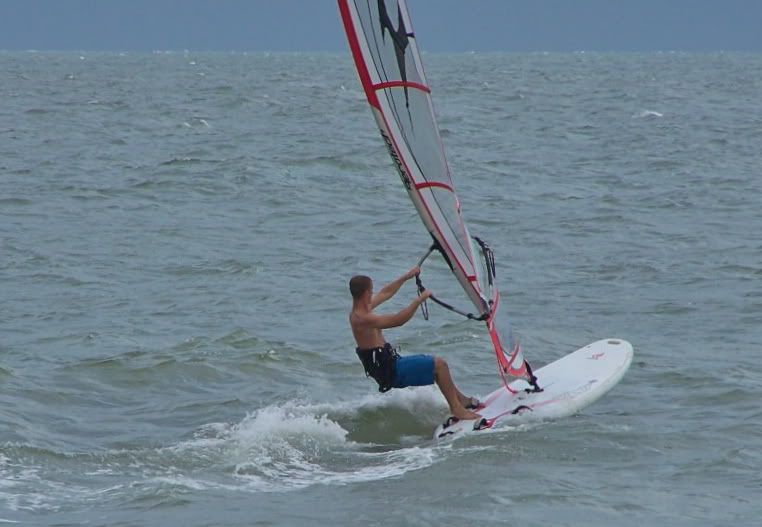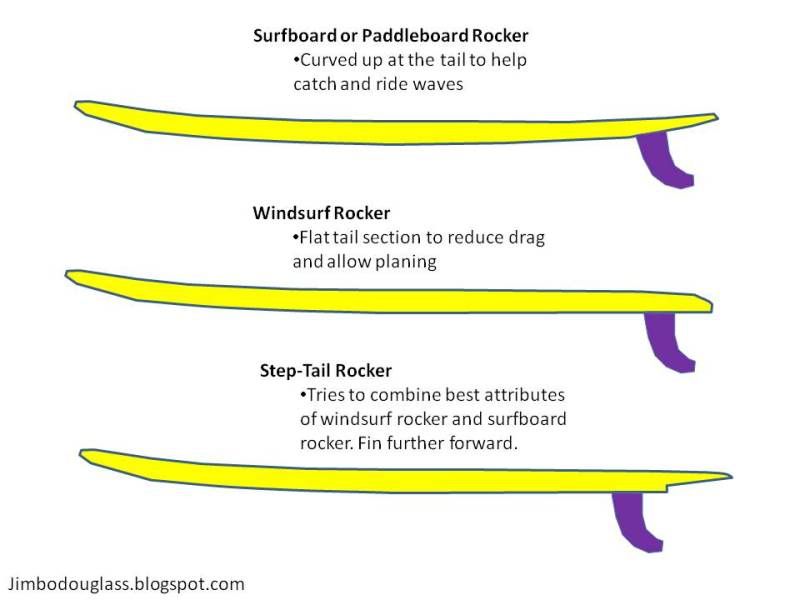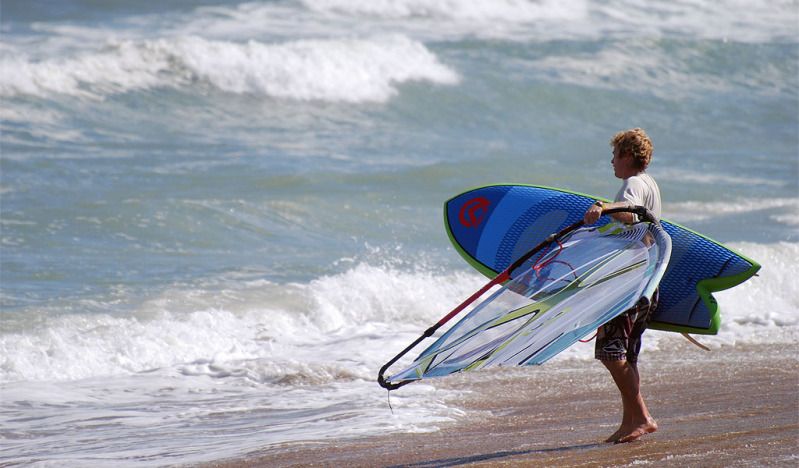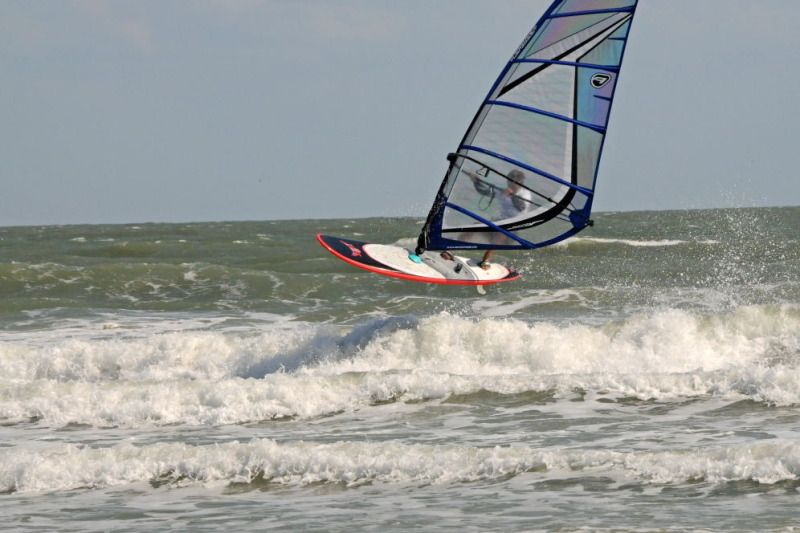Like a lot of windsurfers I was baffled when the stand-up
paddleboard (SUP) craze hit. My thinking was, “How is that even fun? It looks
so slow and awkward.” Only after I tried it a few times did I start to see the
appeal. SUP may not be the fastest way to navigate the water, but it’s
pleasurable in its simplicity, and there’s something about standing on the
surface that’s more fun than sitting in a kayak or sprawling on a surfboard. So
I get it. SUP is legit.
What baffles me now is the unexploited potential in the
design and marketing of multiple use windsurfer – SUP boards. Yes, there are
SUPs with mast tracks that can be windsurfed, and yes, some windsurfing
longboards can be paddled. But with few exceptions, the existing multiple-use boards
are strongly biased towards either SUP or windsurfing, with limited
capabilities for the other sport. I think that’s a shame, for two reasons:
1. There are a lot of things that a big board can potentially
do well. Depending on its design, it can be a stable platform for beginner
windsurfers, it can sail efficiently in light winds with the daggerboard down,
it can carry a large sail for early planing, it can be paddled as a SUP in flat
water or waves, or it can be used as a light-wind windsurfing waveboard.
2. Big boards cost a lot of money and take up a lot
of space. So, it’s hard for most people to own a separate big board for every
possible big-board use. Hence, the desirability of multiple-use big boards.
I’m not exactly sure why board manufacturers have been so
half-assed about adding multi-usability to their big rides, but I have some
theories that I won't get into here. For now, let’s review what types of big boards
are out there, and what kind of multi-use potential they each have. As I’m
prone to do, I made a chart for that, and I’ll say a little bit more about the
categories in the chart:
The columns are grouped by three basic types of big boards.
On the left you’ve got typical big windsurfing boards, which
are designed for flatwater sailing. They optimize non-planing glide, early
planing ability, or some combination of the two. They are not designed to be
paddled or wavesailed, but some work OK as flatwater SUPs. The picture below shows me riding a big beginner windsurfing board in planing conditions.
In the middle are windsurfable SUP boards. They are
windsurfable because they have mast tracks, and occasionally a daggerboard or
removable center fin, but they are otherwise shaped for uncompromised SUP
performance. If they are intended for wave riding then they have soft rails and
lots of rocker at the tail- features that facilitate catching waves with paddle
power and longboard-style surfing but “stick” the board to the water and
prevent it from reaching planing speed under normal sail power. See the figure below:
Given obscene
amounts of sail power a surf-rockered SUP may be coaxed to plane, and in fact there is a video
circulating around that shows a 12’6” SUP planing on flat water, but that’s
with an expert speedsailor using a 6.6 sail in 30 knots of wind. With that much
power even a bathtub would plane.
SUP boards intended for flatwater cruising are rarely
equipped with mast tracks (with some exceptions). That's too bad because a flatwater cruising SUP could really cut through the water fast in light winds. It also seems like it might be easier to design a “planeable”
flatwater cruiser SUP than a planeable surfing SUP, because the former could
have a flat rocker and hard rails. Still waiting to see someone make that
board.
An unusual type of windsurfable SUP board is wide but very
compact, often with a “fish” style tail and multiple fins. Some of these boards
are able to plane, but awkwardly and with no footstraps. They also don’t paddle
in a straight line or catch gentle waves very well, making them most useful for
specialist light-wind wavesailors who have sideshore wind and good waves and favor
a certain shortboard surfing feel. The most famous example of that type of board is the much-hyped AHD SeaLion.
Image of the AHD SeaLion from Bill's OBX Beach Life.
On the far end of the table are step-tail windsurf / SUP
boards, the original and most popular of which is the Kona ONE, which was introduced
by Exocet in 2005 then became it’s own brand with an associated one-design
racing class. The Kona does a bit of everything, but it’s too heavy and boxy to
windsurf great in the waves, and it’s too narrow with too abrupt a step-tail to
SUP well in the waves- I’ve tried.
Exocet later made some other Kona boards (now
called the Curve 11’5”, 10’5”, etc.) with less volume and no daggerboards. The
Curves have unequaled light-wind wavesailing performance but are less
appropriate as all-around windsurfing boards because they have no daggerboards
and their “US Box” fin slots can’t support large fins. Some people SUP them,
but they’re too narrow for most and the abrupt step-tail impedes their wave
catching ability. Below, Florida's John Ingebritsen shreds a wave on a Curve 11'5".
The most recent step-tail offering from Exocet is the WindSUP
11’8”, which looks like a Kona ONE with a wider, thinner shape and a more
refined step-tail design, as seen in the picture from Chuck's blog.

Supposedly it has improved light wind planing ability and SUP ability compared to the Kona ONE. It’s considerably larger than I would ideally want, but I’m encouraged by the mere fact that it exists, proving that it IS possible to have a fully-planing windsurfing board that SUPs well in waves. I really need to test one for myself, I mean, uh, for my fiancé.

Supposedly it has improved light wind planing ability and SUP ability compared to the Kona ONE. It’s considerably larger than I would ideally want, but I’m encouraged by the mere fact that it exists, proving that it IS possible to have a fully-planing windsurfing board that SUPs well in waves. I really need to test one for myself, I mean, uh, for my fiancé.
Conclusion:
Most SUPs and windsurfs on the market are good for their own
sport but have very limited utility for the other sport. Fortunately, recent
designs like Exocet’s WindSUP show that it's not impossible to have a board
that SUPs well in waves AND planes well as a windsurf. Hopefully continued
evolution will refine and diversify those designs, and maybe come up with some
as-yet-unseen designs like a flatwater racing SUP that’s also an efficient
planing and displacement windsurfer.
PS- Late breaking news- Exocet just introduced a 10’0”
WindSUP for 2013! They must have read my mind.





I get my Amundson 11'6 planing pretty easily with big sails (7.5, 8.5 and 9.5), and it moves fast, but it doesn't plane prettily. It doesn't have chines (bottom flat edges) which causes wicked splash up when it planes. It doesn't have a mast track, just a hole for the mast step, and while it works, it's definitely not in the right spot.
ReplyDeleteThe Exocet WindSUP is definitely at the top of my List. Being incredibly poor, I may sell my Amundson / some other boards I picked up to get it.
Hi JSW- That's interesting about the Amundsen. From the ones I've seen it looks like they have a flatter tail section than most SUPs, so I guess it makes sense that they can plane. Would you say the mast track position is too far forward or too far back? How is the maneuverability when riding waves? The smaller Angulo "GU'd" sups also have fairly flat rocker and will plane ok if you give them strong sail power. I found it helped if I took out the thruster fins because they were toed in too much and would cavitate at planing speed. The GU'd boards are definitely trickier to maneuver on waves than the heavily rockered Angulo "Surfa" boards.
ReplyDeleteThe mast position is too far forward. Probably 1.5 inches.
ReplyDeleteI've only ever tried to get it out sailing in the waves twice. Both times at Cape May New Jersey over a weekend, and both times with perfectly onshore 10-11 knots of wind. Being a wave sailing novice, I got my butt kicked. Couldn't even get up and out of the break.
I tried straight paddle surfing a bit, and was moderately successful, but still got my butt kicked by the quick waves and onshore wind.
Don't forget the RRD Wassup series. I have the 8'5'' model, which is a superb intermediate SUP surfboard, and--with a mast insert and footstrap inserts--offers a maneuverable and plan-able windsurfing ride... (They even make them with optional daggerboard inserts)
ReplyDeletehttp://shop.nbwindsurfing.com/RRD-WASSUP_p_205.html
Thanks for breaking this all down James. Like you, I'm amazed more hasn't been done to sell these boards as crossovers and to create better multiple-use boards. Seems to me that the SUP craze could bring more people back to windsurfing, especially with some of those cool new one-piece sails that folks are making:
http://www.youtube.com/watch?v=4DQDaDkA0LI
Cheers,
James
RE the Amundson boards, check out Dwight Fischer's blog: http://ncpaddlesurfer.blogspot.com/
ReplyDeleteHe's got them planing, and surfing, although he rides the 11'3".
Hi James,
ReplyDeletevery nice post, the seek for best cross-sport board has been on my mind for a while, but I couldn´t summarize better.
There´s one thing it surprised me on the comparison chart. You give a better planning performance to the Windsup 11.8 than to Kona One.
For family reasons, now I mostly SUP (race), but I have windsurfed a lot, and I own a Kona One and shortboards. And I would rate the planing performance of the Kona one as very good (taking into account it´s size)
Windsup will do better? Anybody you know have tested?
Keep up with the blog! Very inspiring
MarcC
PS: let´s watch up for new windsup 10, might even be kitesup'ed
Marc- I'll need to test it to confirm, but the Windsup is 10 cm wider than the Kona ONE so I would expect it's capable of planing earlier. In my experience the Kona ONE definitely planed "well" but it didn't plane "early."
ReplyDeleteNice post.
ReplyDeleteI have a similar comment regarding planing and the Kona One. It is definitely better and easier on the plane than classic longboards. The step tail really helps.
Yan aka Sailboarder
@Sailboarder and Marc - Yeah, I reckon I should have given the Kona ONE three stars for planing, or at least two and 1/2, since it does plane better than a traditional old longboard like a mistral equipe.
ReplyDeleteLet us know if you test the windsup planing. If it really planes a little bit earlier it could be the THE all-around board
ReplyDeleteA bonus for this board would be a quick clip-on footstrap system, so that you can easily put-remove footstraps, so that switch from SUP-WS is practical (I don´t think the board will stand screwing on-off footstraps many times). At least for front footstraps
Cheers!
MarcC- I haven't tested one yet, but a friend here in MA is getting one, and there's a slight possibility that I'll be able to "help tune it up for him" this week before I move to Florida. :) I also talked to John Ingebritsen recently and he's been riding the 2013 WindSUP 10'0". He says both the 11'8" and the 10'0" plane a good bit earlier and are easier to do a planing jibe on than the Kona ONE. The max sail size for each board is listed as 8.0, but John says they feel good with bigger sails and estimates they'll hold 12.5 and 9.5, respectively.
ReplyDeleteI agree that a durable, easily changeable footstrap system is long overdue.
I also have my eye on the 10' Exocet. I just sold my 11'3 Amundson with a mast track and it's time to go shopping. The 11'8 was awesome and I can't wait to try the new 10'. Where in Florida are you moving to?
DeleteI'm in Jupiter.
I used to live pretty near Jupiter, in Fort Pierce, but this time I'm moving to SW Florida- Bonita Springs.
DeleteI've been paddling north and south of there. Ten thousand Islands and near Port Charlotte. I'll have to come visit when the wind comes from the west.
DeleteI'm heading up to cocoa/Titusville area on Sunday to check out the 10' windsup prototype. Gotta see it!
Interesting thread. Like you James, initially the sup/windsurfing concept did not grab me. This year , however, the wind has not been plentiful in Mass.
ReplyDeleteMy interest was piqued by the light wind windsurfing possibilities coupled with a suggestion from Andy Brandt last year at the Hyannis ABK camp. A post on I windsurf about the virtues of light wind wave sailing and discussions with Jim Ballantyne at Sailworld won me over. I purchased a Exocet Evo 10'9. Sailing in light wind small waves has been a blast. It is a bit tippy for me at 210 when paddled.
I've only paddled twice. I bought it not expecting it to plane but work great in the waves and when the wind dies paddle in the same waves. It is the Swiss army knife of water sports. It is a great opportunity for the industry to expand the windsurfing universe.
Hey James, very analytical an article... ;)
ReplyDeleteI've been experimenting a lot with a SUPer 12'6" with it's 6.5m Dacron sail, from Starboard (given to me by same manufacturer - no I'm not on the payroll).
It was a slow start, but frankly, wow am impressed.
- SUPability: works, of course. Am not a SUP fan, so...
- for teaching: great plank, with its incredibly light sail. One can learn on a real sail 6.5m, and not those 3.5m you find in schools, that don't teach that much. The retractible dagger also helps a lot on on-shore winds - makes the newbie more confident about not hitting bottom.
- pointing upwind: it's a bit lame, like most SUPs with the round edge. Points even less than the old Windsurfer.
- freestyle: quite good. Plenty of railrides, actually got a couple of moves that I couldn't do on a Windsurfer - me surprised... I still don't like wider boards like this for freestyle, it kills too many of the possibilities on the rail and the board upside down.
- speed: was able to make it sail up to about 18 knots. After that, the Dacron sail sort of folds at the top (which is cute to observe). Planes well, don't need the footstraps.
- transitions: gybes by itself. Tacking: going upwind a little slow.
In the end, one surmises the above is true of most larger SUPs with light sails and dagger on 'em...
I really like your blog. I really appreciate the good quality content you are posting here for free. I was looking to buy an bravo hand pump but was looking for all the characteristics. Thanks for sharing all the information with us.
ReplyDeleteI have an Amundson 14' TR-T abd plan to windsurf on it. How does it work without a dagger board and not sideslip in the wind?
ReplyDeleteThanks,
Chris
Hi Chris,
ReplyDeleteThe waterline of the board itself provides some of the same anti-slip function as a daggerboard, especially when the board is long and the edges are sharp. With a daggerboard you could go perhaps 40 degrees into the wind, without it maybe 20 degrees into the wind. Of course, you need a bit of forward speed in order for the waterline to grip instead of slip, so in very light winds is when you'll miss the daggerboard most. At really high speeds the front half of the board rises up out of the water and the anti-slip resistance is provided mostly by the tail fin.
-James
Thanks James, the avg. wind is 8-12 in Seattle, would a huge windsurfing fin help? I'm thinking of buying a new Starboard Rio L longtail (233L) and once I learn, I trying to figure out what size of sail I will need, I weighh 215 and hope a 6.4 Goya Nexus would work?
ReplyDeleteHi Chris-
ReplyDeleteYes, a bigger tail fin will help a bit with going upwind, although it won't make as big a difference as having a daggerboard. The starboard rio L longtail would be a good first windsurfing board for you, and the 6.4 nexus will be a good sail. If it's your very first time uphauling a sail 6.4 might feel a bit big, but once you're used to it you'll have no problem handling it in typical 8-12 mph Seattle wind. At this point your goal is basically just to get from point A to point B and back again. You don't need to worry about if you getting "planing" or anything, so the sail size is not that critical.
-J
I just ordered the starboard rio L (20% off at local shop and no $185 shipping fee for longtail) and will start out with 4.5 used rig I found on CL and plan to move up to a bigger sail lster this summer and will use your wind/sail calculator and thinking sailworks 9.0 (weigh 215, avg. wind 8-12, board volume 225L).
ReplyDeleteThere's a pretty huge difference between the weight and feel of a 4.5 and a 9.0. Most people would probably get something in the 6.5-7.5 range before stepping all the way up to 9.0, even if 9.0 is where they eventually want to be. Sailworks is a good brand.
ReplyDeleteThanks, hoping to avoid muliple masts!
ReplyDeleteMe again - rethinking the Rio, learn on my Amundson over the next 6-12 months and then move to a 161L Starboard Go with centerboard. I think that with my extensive surfing, SUP, and sailing I can by pass a beginner board and I will soon be down to 200 lbs by the end of this summer.
ReplyDeleteHi Chris,
ReplyDeleteA GO would be a good first shortboard for you, but it's only going to work well in planing conditions, like 12-20 knots depending on sail size. If you want to do sailboat style cruising in 6-12 knots you'd be better off with a high-volume longboard like a Kona ONE or an older mistral raceboard or something.
-James
Someone I work with is selling a 12' flyboard and 5.0 sail for $300, do you know anything about flyboards?
ReplyDeleteI've never heard of flyboard, but the price sounds nice.
ReplyDelete